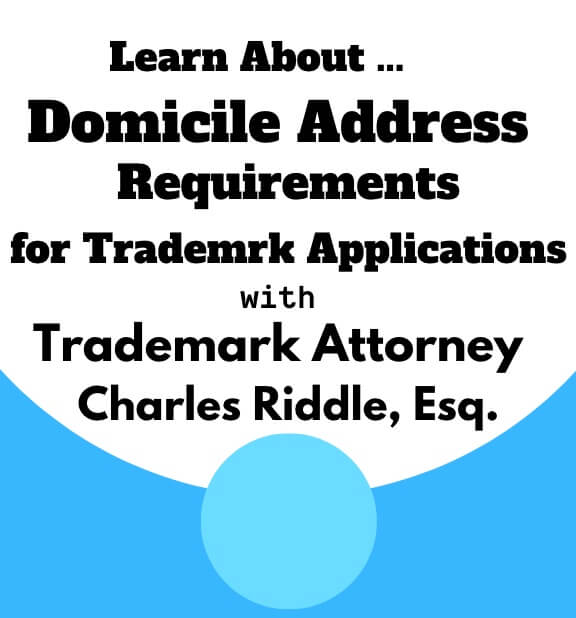The Domicile Address Requirement of the Trademark Office?
So, you’re on the exciting path of trademarking your brand, but you’ve just received an Office Action from the trademark office. Don’t panic! This is a common part of the process. Often, these actions request clarification or corrections on certain aspects of your application. One frequent point of inquiry? The domicile address.
You might be staring at your Office Action wondering, “What exactly is a domicile address, and why is the trademark office raising this issue?” This article will break down this essential requirement, explain its significance, and, importantly, help you understand why it might be highlighted in an Office Action and how to respond correctly.

What Exactly is a Domicile Address? (The Trademark Office is Asking!)
In trademark terms, your domicile address is the physical location where you, the applicant, primarily reside or where your business has its main operational hub. For individuals, this is usually your home. For businesses, it’s the principal place of business.
Think of it as the official “home” for your trademark matters. The trademark office uses this address for all official communication, legal notices, and crucial updates regarding your application and registration. An Office Action pointing to the domicile address often means there’s a question about the clarity, completeness, or acceptability of the address you provided.
What’s a No-Go? Unacceptable Domicile Addresses (According to Trademark Office Rules)
When providing your domicile address, it’s crucial to understand what the trademark office doesn’t accept. Getting this wrong is a common reason for Office Actions, as we discussed. According to the Trademark Manual of Examining Procedure (TMEP) Section 601, certain types of addresses are generally not considered a proper domicile.
Here’s a breakdown of what typically won’t cut it:
- Post Office (P.O.) Boxes: This is a big one. The trademark office generally requires a physical street address. P.O. boxes don’t indicate a physical residence or principal place of business. As TMEP § 601.03 explicitly states regarding the applicant’s address, “The address of the applicant must be a street address or rural route and box number. A post office box is not acceptable unless no street address exists.” This exception for when no street address exists is very narrow and would require justification.
- Commercial Mail Receiving Agencies (CMRAs) – with Caveats: While you can sometimes use a CMRA address as a mailing address for receiving correspondence, it’s generally not acceptable as the domicile address itself, especially if it obscures the true physical location. The trademark office needs to know the actual physical place of residence or business. TMEP § 601.03(a) addresses this, noting the requirements for providing additional information to identify the applicant’s actual location when using a CMRA as a mailing address. This underscores the preference for a direct physical address as the domicile.
- Incomplete or Vague Addresses: Addresses lacking essential information like a street number, street name, city, state, or zip code will be rejected. The office needs a precise location for proper communication and record-keeping.
- Addresses That Don’t Clearly Identify the Applicant’s Location: If the address provided is for a third-party agent or representative (unless they are the applicant), it won’t be accepted as the applicant’s domicile. The domicile must be the applicant’s own physical residence or principal place of business.
Key Takeaway from TMEP § 601: The overarching principle is that the domicile address must be a physical location that clearly identifies where the applicant resides or conducts their primary business. While a separate mailing address can be provided for convenience, the domicile needs to be the “home base.”
Understanding these limitations can save you time, prevent delays caused by Office Actions, and ensure your trademark application progresses smoothly. When in doubt, always provide a complete and accurate physical street address as your domicile.
Why is the Domicile Address So Important to the Trademark Office (and Why It’s in Your Office Action)?
The trademark office emphasizes a valid domicile address for several vital reasons, and these are likely the underlying concerns prompting the inquiry in your Office Action:
- Clear Official Communication: The office needs a reliable physical address to send important documents. An Office Action might cite an issue if the address is incomplete, a P.O. box, or unclear. You might see language like, “The applicant must provide a clear and definite domicile address.”
- Establishing Legal Basis: The domicile can influence legal jurisdiction. An Office Action might question the address if it seems inconsistent with other information provided or if it’s unclear where the applicant is truly located.
- Applicant Verification: The domicile helps confirm the applicant’s identity and location. If the address seems questionable or doesn’t align with publicly available information, it could trigger an inquiry in the Office Action. You might see a statement like, “Further clarification is needed regarding the applicant’s domicile.”
- Public Record Accuracy: Once registered, this address is public. An Office Action might seek to ensure this information is accurate and reflects the true owner.
Decoding Your Office Action: Domicile Address Specifics
If your Office Action specifically mentions the domicile address, it might include phrases like:
- “The address provided appears to be a post office box and is not acceptable as a domicile address.”
- “Please clarify the applicant’s domicile address. The current address is insufficient.”
- “There is an inconsistency between the applicant’s domicile address and other information in the application.”
- “Provide the complete street address, including street number and name, for the applicant’s domicile.”
Responding Effectively to a Domicile Address Inquiry in Your Office Action:
- Review Carefully: Understand exactly what the trademark examiner is asking.
- Provide a Clear Physical Address: If a P.O. box was used, provide your physical street address.
- Double-Check Accuracy: Ensure every detail (number, street, city, state, zip code, country if applicable) is correct.
- Explain Inconsistencies: If there was a reason for a particular address (e.g., business operations are separate from a mailing address), clearly explain this while still providing the correct domicile.
- Respond Promptly: Adhere to the deadline stated in the Office Action.
Don’t Navigate Your Office Action Alone
Receiving an Office Action can feel daunting, but addressing the domicile address requirement correctly is a crucial step in securing your trademark. As an experienced trademark attorney, I can help you understand the nuances of your Office Action, craft a precise and effective response, and guide you through the entire trademark process.
If you’ve received an Office Action concerning your domicile address or any other aspect of your trademark application, reach out today for expert guidance.
Consult a Licensed Trademark Attorney:
Charles Riddle at EsquireTrademarks.com has 20+ years experience practicing trademark, copyright, and intellectual property law. We can answer your legal questions on the spot. We use our experience to guide you through the trademarking process and avoid common pitfalls.
